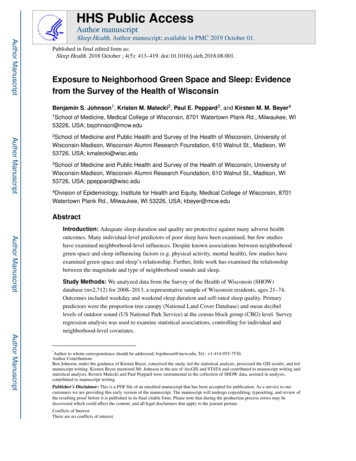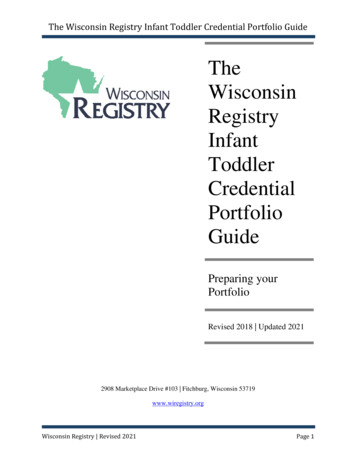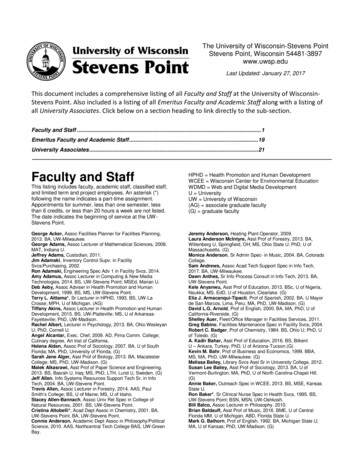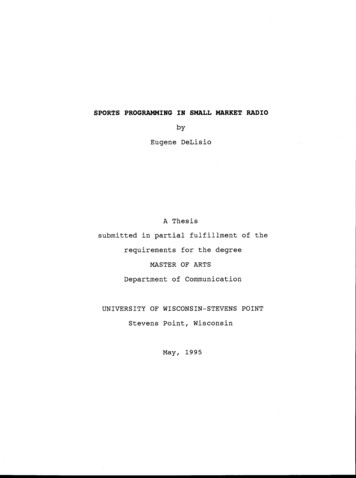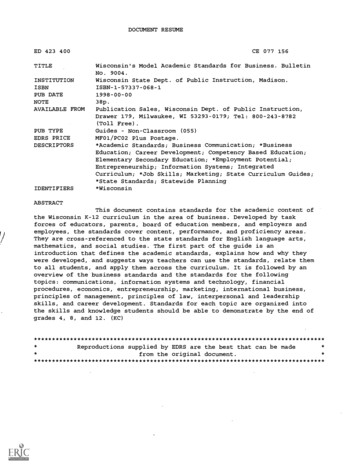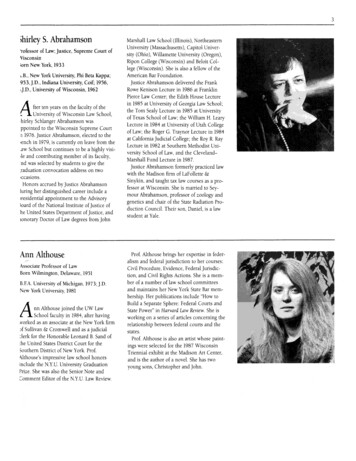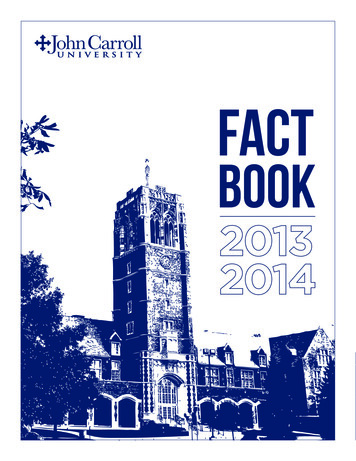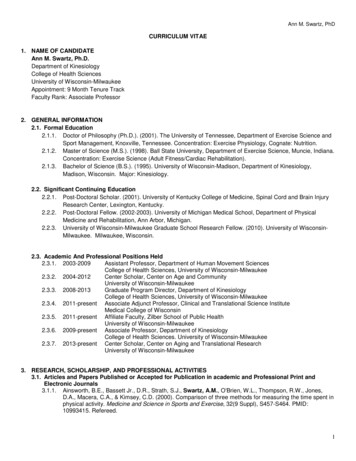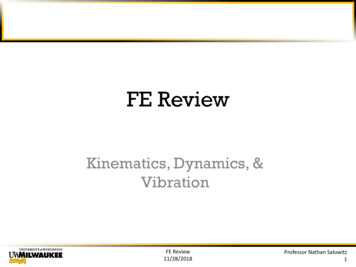
Transcription
FE ReviewKinematics, Dynamics, &VibrationFE Review11/28/2018Professor Nathan Salowitz1
Tactics Answer easy questions you know firstCome back to hard questionsOnce answered don’t look backUse books and tables to save timeFE Review11/28/2018Professor Nathan Salowitz2
TopicsBasics Center of gravity Mass & weight Inertia Mass moment of inertia Parallel axis theorem Radius of gyration Principle axesKinematics: Particles & rigid Bodies Coordinate systems Linear particle motion Distance & speed Uniform motion Uniform acceleration Linear acceleration Projectile motion Rotational particle motion Relation between linear and rotational variables Normal acceleration Coriolis acceleration Particle motion in polar coordinates Relative motion Dependant motion General planar motion Rotation about a fixed axis Instananious center of acceleration Sliders Crank Sliders 4 bar linkages Rigid Body motionEquilibrium & StabilityConstant forcesLinear forcesBallistic pendulumAngular momentumNewton’s laws of motionCentripital forceDynamic equilibriumFrictionRoadway/conveyor bankingRigid body motionConstrained motionCables & tension from suspended accelerating massesImpluseImpulse – momentumImpactsCoefficient of restitutionGravitationKinetics:FE Review11/28/2018Professor Nathan Salowitz3
Definitions Kinematics : Geometry of motionindependent of forces Linkages Kinetics : Acceleration and motion Vector : magnitude & direction I Mass moment of inertiaFE Review11/28/2018Professor Nathan Salowitz4
General Problem Solving Understand the problem Identify desired resultIdentify unknownsIdentify knownsDraw Diagrams Establish a coordinate system Identify theory and equations that relateresults to knowns Does it make sense?FE Review11/28/2018Professor Nathan Salowitz5
Vector Properties Magnitude & direction Commonly break into orthogonal components:𝐴Ԧ 𝐴𝑥 𝑥,ො 𝐴𝑦 𝑦,ො 𝐴𝑧 𝑧ƸMagnitude:𝐴Ԧ 𝐴𝑥 2 𝐴𝑦 2 𝐴𝑧 2Direction:𝐴Ԧ𝐴መ 𝐴Ԧ Add Sum components:𝐴Ԧ 𝐵 𝐴𝑥 𝐵𝑥 , 𝐴𝑦 𝐵𝑦 , 𝐴𝑧 𝐵𝑧 Subtract Add negativeFE Review11/28/2018Professor Nathan Salowitz6
Vector Manipulation Dot Product: projection of one vector ontoanother Scalar : 𝐴Ԧ 𝐵 𝐴𝑥 𝐵𝑥 𝐴𝑦 𝐵𝑦 𝐴𝑧 𝐵𝑧Commutative: 𝐴Ԧ 𝐵 𝐵 𝐴ԦDistributive : 𝐴Ԧ 𝐵 𝐶Ԧ 𝐴Ԧ 𝐵 𝐴Ԧ 𝐶Ԧ Cross Product: Perpendicular vector ofmagnitude of the orthogonal space between 2vectors Vector :𝐴Ԧ 𝑥 𝐵 ൻ𝐴𝑦 𝐵𝑧 𝐴𝑧 𝐵𝑦 , 𝐴𝑧 𝐵𝑥 𝐴𝑥 𝐵𝑧 , 𝐴𝑥 𝐵𝑦 FE Review11/28/2018Professor Nathan Salowitz7
Basics: Properties of Solid Bodies Center of GravityMass and WeightInertiaMass Moment of InertiaParallel Axis TheoremRadius of GyrationPrinciple AxesFE Review11/28/2018Professor Nathan Salowitz8
Center of Gravity Center of Mass Volumetric centroid of a homogenous body On axis of symmetry 𝑥𝑐 𝑦𝑐 𝑧𝑐 𝑚𝑑 𝑥 𝑚 𝑚𝑑 𝑦 𝑚 𝑚𝑑 𝑧 𝑚FE Review11/28/2018Professor Nathan Salowitz9
Mass & Weight Mass: Independent of gravitational fieldMeasure of inertia Weight: Depends on gravitational field acting on massFE Review11/28/2018Professor Nathan Salowitz10
Inertia Resistance to changes in linear speed Inertial force 𝑚𝑎ԦFE Review11/28/2018Professor Nathan Salowitz11
Mass Moment of Inertia Resistance to changes in rotational speed References about axis of rotation About centroid: 𝐼𝑥 𝑦 2 𝑧 2 𝑑𝑚 𝐼𝑦 𝑥 2 𝑧 2 𝑑𝑚 𝐼𝑧 𝑥 2 𝑦 2 𝑑𝑚 Look it upFE Review11/28/2018Professor Nathan Salowitz12
Parallel Axis Theorem Mass moment of inertia about other axes 𝐼𝑝𝑎𝑟𝑎𝑙𝑙𝑒𝑙 𝐼𝑐𝑒𝑛𝑡𝑟𝑜𝑖𝑑 𝑚𝑑 2FE Review11/28/2018Professor Nathan Salowitz13
Radius of Gyration : k Equivalent distance form rotational axis atwhich entire mass could be located 𝑘 𝐼𝑚 𝐼 𝑚𝑘 2FE Review11/28/2018Professor Nathan Salowitz14
KinematicsParticles & rigid BodiesCoordinate systemsLinear particle motionDistance & speedUniform motionUniform accelerationLinear accelerationProjectile motionRotational particle motionRelation between linearand rotational variables Normal acceleration Coriolis acceleration Particle motion in polarcoordinates Relative motion Dependent motion General planar motion Rotation about a fixed axis Instantaneous center ofacceleration Sliders Crank Sliders 4 bar linkagesFE Review11/28/2018Professor Nathan Salowitz15
Kinematics Study of a body’s motion independent offorces involved Position, velocity, & accelerationFE Review11/28/2018Professor Nathan Salowitz16
Particles vs. Rigid Bodies Particles aren’t concerned with rotation Rotation is absent or insignificantKinetic energy of rotation is smallAll parts have the same instantaneousdisplacement, velocity, and acceleration Rigid bodies Body does not deform (significantly)Can be idealized as a combination of 2 or moreparticles that remain a fixed finite distance fromeach otherParticles can have differing displacement, velocityand accelerationFE Review11/28/2018Professor Nathan Salowitz17
Coordinate Systems Need a reference! Rectangular : CartesianPolarCylindricalSpherical Coordinates in 3D 3 location3 orientationFE Review11/28/2018Professor Nathan Salowitz18
Position, Velocity, & Acceleration Position 𝑠Ԧ 𝑡𝑑)𝑡𝑑 𝑡 𝑎 ( 𝑡𝑑 𝑡 𝑣 Relative to a reference Velocity 𝑣Ԧ 𝑑 𝑠Ԧ𝑑𝑡 𝑡𝑑 𝑡 𝑎 Acceleration 𝑎Ԧ 𝑑𝑣𝑑𝑡 𝑑 2 𝑠Ԧ𝑑𝑡 2FE Review11/28/2018Professor Nathan Salowitz19
Distance vs. Dispalcement Displacement : Net change in particleposition Path independentFinal position – initial position Distance : Path dependant change inparticle location Accumulated length of path traveled includingreversals𝐷𝑖𝑠𝑡𝑎𝑛𝑐𝑒 𝐷𝑖𝑠𝑝𝑙𝑎𝑐𝑒𝑚𝑒𝑛𝑡FE Review11/28/2018Professor Nathan Salowitz20
Speed vs. Velocity Speed is a scalar Magnitude of velocityDirection not considered Velocity is a vector Magnitude and direction.FE Review11/28/2018Professor Nathan Salowitz21
Uniform Motion & Acceleration Uniform Motion Constant velocity : zero acceleration Linear change in position with time Uniform Acceleration Constant acceleration Linear change in velocity with time Second order, parabolic change in position withtimeFE Review11/28/2018Professor Nathan Salowitz22
Linear 1000051015202510000t80002nd order parabolic6000s5v04000200000510152025t3rd order cubicFE Review11/28/2018Professor Nathan Salowitz23
Projectile Motion (Without Drag) Great example of decoupling orthogonalequations Horizontal: no forces constant velocity Vertical: constant gravitational accelerationFE Review11/28/2018Professor Nathan Salowitz24
Rotational Particle Motion Position : angle 𝜃Ԧ 𝑡𝑑)𝑡𝑑 𝑡 𝛼 ( 𝑡𝑑 𝑡 𝑤 Relative to a reference Angular velocity 𝑤 𝑑𝜃𝑑𝑡 𝑡𝑑 𝑡 𝛼 Angular acceleration 𝛼Ԧ 𝑑𝑤𝑑𝑡 𝑑2𝜃𝑑𝑡 2FE Review11/28/2018Professor Nathan Salowitz25
Linear & Angular Relations 𝑣𝑡 𝑤𝑟 𝑎𝑡 𝛼𝑟 𝑎𝑛 𝑣𝑡2𝑟 𝑟𝑤 2 𝑣𝑡 𝑤an Coriolis𝑎𝑐 2𝑣𝑟 𝑤FE Review11/28/2018Professor Nathan Salowitz26
Relative Motion Motion of a particle compared to anotherparticle that is in motion 𝑠𝐵/𝐴 𝑠𝐵 𝑠𝐴 𝑣𝐵/𝐴 𝑣𝐵 𝑣𝐴 𝑎 𝐵/𝐴 𝑎𝐵 𝑎𝐴FE Review11/28/2018Professor Nathan Salowitz27
Dependent Motion Connected masses and systems Motion of one part is coupled to motion ofother parts PulleysLinkagesFE Review11/28/2018Professor Nathan Salowitz28
General Planar Motion Translation & rotationFE Review11/28/2018Professor Nathan Salowitz29
General Planar Motion Translation & rotationFE Review11/28/2018Professor Nathan Salowitz30
Instantaneous Center 2 points on rigid body with known velocity Draw lines perpendicular to velocitiesIntersection is instantaneous center If velocities are parallel but differentmagnitude Draw a line perpendicular to velocitiesDraw line from vector tipsIntersection is instantaneous centerFE Review11/28/2018Professor Nathan Salowitz31
Linkages Crank Slider Review 360 PositionsVelocitiesAccelerationsFE Review11/28/2018Professor Nathan Salowitz32
Fastener Patterns (366) Force analysisFind centroidMoment analysisSum1 ind1 d3 d5 0.25 inchd2 d4 0.5 inchF 1000 lbf1 in1 in0.5 in1 inF5311 in24FE Review11/28/2018Professor Nathan Salowitz33
Kinetics Rigid Body motionEquilibrium & StabilityConstant forcesLinear forcesBallistic pendulumAngular momentumNewton’s laws of motionCentripetal forceDynamic equilibriumFrictionRoadway/conveyor bankingRigid body motionConstrained motionCables & tension fromsuspended acceleratingmassesImpulseImpulse – momentumImpactsCoefficient of restitutionGravitationFE Review11/28/2018Professor Nathan Salowitz34
Main Topics Momentum Forces &acceleration Energy Linear RotationalFE Review11/28/2018Professor Nathan Salowitz35
Newton’s Laws of Motion1) A particle at remain in a state of rest or in astate of constant velocity unless an unbalancedforce acts upon it.2) The acceleration of a particle is directlyproportional to the force acting on it andinversely proportional to its mass. The directionof acceleration is aligned with the force.3) For every acting force between two bodies,there is an equal but opposite reacting force onthe same line of action.FE Review11/28/2018Professor Nathan Salowitz36
Rigid Body Motion Pure translation Rotation about a fixed axis General planar motion (2D translation androtation) Motion about a fixed point (3D rotation) General motion (motion not falling intoother categories)FE Review11/28/2018Professor Nathan Salowitz37
Stability & EquilibriumFE Review11/28/2018Professor Nathan Salowitz38
Momentum Momentum is conserved when no externalforces act on a particle or system Linear:𝑝Ԧ 𝑚𝑣Ԧ Angular:ℎ 𝑟Ԧ 𝑥 𝑚𝑣ԦFE Review11/28/2018Professor Nathan Salowitz39
Energy Kinetic Energy Liner : 𝐾 Angular: 𝐾1𝑚𝑣 221 𝐼𝑤 22 Potential Gravitational : 𝐸 𝑚𝑔ℎSpring: 𝐸 1𝑘𝑥 22FE Review11/28/2018Professor Nathan Salowitz40
Equations of Motion Linear 𝐹Ԧ 𝑚𝑎Ԧ 𝑑𝑚𝑣Ԧ𝐹 𝑑𝑡 Angular 𝑀 𝐼 𝛼ԦFE Review11/28/2018Professor Nathan Salowitz41
Impulse 𝐿𝑖𝑛𝑒𝑎𝑟 𝑑𝑚𝑣Ԧ𝐹 𝑑𝑡𝑚(𝑣2 𝑣1 ) 𝐼𝑚𝑝 𝑡2 𝐹 𝑡 Ԧ1𝑡2 𝐹 𝑡 Ԧ1𝑑𝑡𝑑𝑡 Angular 𝐼𝑚𝑝 𝑡2 𝑇 𝑡 1𝑑𝑡Example 1FE Review11/28/2018Professor Nathan Salowitz42
Impacts Momentum of system is conserved Kinetic energy may be transformed to heat Coefficient of restitution : e Perfectly elastic e 1Perfectly inelastic e 0𝑒 𝑟𝑒𝑙𝑎𝑡𝑖𝑣𝑒 𝑠𝑒𝑝𝑎𝑟𝑎𝑡𝑖𝑜𝑛 ��𝑖𝑣𝑒 𝑎𝑝𝑝𝑟𝑜𝑎𝑐ℎ 𝑣𝑒𝑙𝑜𝑐𝑖𝑡𝑦FE Review11/28/2018 𝑣′1 𝑣′2𝑣2 𝑣1Professor Nathan Salowitz43
Mechanisms & Power Transmission Power ScrewsEnergy Storage in FlywheelsRotating Solid DisksRotating RingsRotating HubsRotating Fluid MassesRim FlywheelsGear TrainsCamsMoreFE Review11/28/2018Professor Nathan Salowitz44
Review 366 A press with twin screws hasbeen rated to 5000 lbf.Screws have ACME threadswith outer diameter of 2inches and a pitch of ¼ inch.Coefficients of friction are0.05 for the threads and 0.08for the collars. Collars have adiameter of 3.5 inches. Gearshave a ratio of 60:1 and anefficiency of 95%. The fullload motor speed is 1720 RPM How fast will the press move &how much power is required?FE Review11/28/2018Example 42Professor Nathan Salowitz45
Vibration Free / Forced Undamped / Damped Boundary conditionsFE Review11/28/2018Professor Nathan Salowitz46
Fundamental Equation(s) Spring MassRelate forces and accelerations 𝑘𝑠 𝑚𝑠ሷ0 𝑚𝑠ሷ 𝑘𝑠𝑠(𝑡) 𝑒 𝑟𝑡0 𝑚𝑟 2 𝑘 r 𝑖𝑘𝑚 natural frequency of undamped free vibration 𝑤𝑛 𝑘𝑚FE Review11/28/2018Professor Nathan Salowitz47
Flexural Vibration of a Beam From Euler Bernoulli Beam Theory𝑑 2 𝑠(𝑥, 𝑡)′′𝑀 𝐸𝐼 𝐼𝐸𝑠2𝑑𝑥𝑉 𝐼𝐸 𝑠 ′′′𝐹 𝐼𝐸 𝑠 ′′′′ Equation of motion𝐼𝐸 𝑠 ′′′′ 𝑚𝑠ሷ 0 Pinned Pinned Natural Frequencies 𝑤𝑗 𝜋 2𝑗𝑙𝐸𝐼𝑚FE Review11/28/2018Professor Nathan Salowitz48
Torsional Equation of motion 𝑘𝑟 𝜃 𝐼 𝜃ሷ 𝑘𝑟 𝑤 𝐺𝐽𝐿for a round section J 𝜋𝑑 432𝜋𝑑4 𝐺32𝐿𝐼FE Review11/28/2018Professor Nathan Salowitz49
Other Forced Vibration : Add a forcing term to theequations of motion Damped vibration : Add a velocitydependent damping force to the equationsof motionFE Review11/28/2018Professor Nathan Salowitz50
Recommended Resources Hibbeler, Engineering Mechanics series :Statics, Dynamics, Mechanics of Materials Beer & Johnson, Vector Mechanics forEngineers series: Statics, Dynamics,Mechanics of Materials Norton, Design of Machinery (360) Shigley’s Design of Machine Elements (366) Mechanical Engineering Reference Manualfor the PE ExamFE Review11/28/2018Professor Nathan Salowitz51
FE Review 11/28/2018 Professor Nathan Salowitz 2 Tactics Answer easy questions you know first Come back to hard questions Once answered don't look back Use books and tables to save time. FE Review 11/28/2018 Professor Nathan Salowitz 3 Topics Basics Center of gravity Mass & weight Inertia Mass moment of inertia
